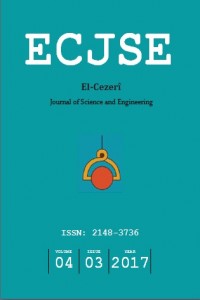Abstract
Çift fazlı paslanmaz çeliklerin kaynağında, yüksek
ısı girdisine bağlı olarak ferrit/östenit faz dengesi değişmekte ve çeşitli
intermetalik fazlar oluşabilmektedir. Özellikle, ısı etkisi altındaki bölge
(IEAB) ferrit/östenit faz dengesinin değişimine ve intermetalik faz oluşumuna
karşı oldukça hassastır. Bu nedenle kaynak işlemi sırasında özellikle IEAB’de
oluşan sıcaklık eğimcesinin belirlenmesi oldukça önemlidir. Bu çalışmada,
IEAB’deki sıcaklık dağılımının belirlenmesi için ANSYS yazılımı kullanılmıştır.
IEAB’de oluşan en yüksek sıcaklık değeri belirlenmiş, analizler sonucu elde
edilen soğuma hızı değerleri, teorik olarak hesaplanan değerler ile
karşılaştırılmıştır.
Keywords
References
- [1] Alvarez-Armas, I., Duplex Stainless Steels: Brief History and Some Recent Alloys, Recent Patents on Mechanical Engineering, 1 (2008) 51–57. [2] Kısasöz, A., Gürel, S., Karaaslan, A., Effect of Annealing Time and Cooling Rate on Precipitation Processes in a Duplex Corrosion-Resistant Steel, Metal Science and Heat Treatment, 57 (2016) 544-547. [3] Kısasöz, A., Karaaslan, A., Finite Element Analysis of 2205 Duplex Stainless Steel Welds, Materials Testing, 56 (2014) 795-799. [4] Asif, M., Shrikrishana, K.A., Sathiya, P., Finite Element Modelling and Characterization of Friction Welding on UNS S31803 Duplex Stainless Steel Joints, Engineering Science and Technology, 18 (2015) 704-712. [5] El Bartali, A., Evrard, P., Aubin, V., Herenú, S., Alvarez-Armas, I., Armas, A.F., Degallaix-Moreuil, S., Strain Heterogeneities Between Phases in a Duplex Stainless Steel: Comparison Between Measures and Simulation, Procedia Engineering, 2 (2010) 2229-2237.
Abstract
In welding of DSS, austenite/ferrite phase ratio can vary and various
intermetallic phases may occur in weld metal due to excessive heat input.
Especially, HAZ is very sensitive against the variation of austenite/ferrite
phase ratio and formation of intermetallic phases. Thus, determining the
temperature gradient in welding is very crucial. In this study ANSYS workbench
was used for defining the temperature gradient in HAZ. The peak temperature in
HAZ generated during the welding was determined and also, cooling rates of the
analysis were compared with theoretical cooling rate values.
Keywords
References
- [1] Alvarez-Armas, I., Duplex Stainless Steels: Brief History and Some Recent Alloys, Recent Patents on Mechanical Engineering, 1 (2008) 51–57. [2] Kısasöz, A., Gürel, S., Karaaslan, A., Effect of Annealing Time and Cooling Rate on Precipitation Processes in a Duplex Corrosion-Resistant Steel, Metal Science and Heat Treatment, 57 (2016) 544-547. [3] Kısasöz, A., Karaaslan, A., Finite Element Analysis of 2205 Duplex Stainless Steel Welds, Materials Testing, 56 (2014) 795-799. [4] Asif, M., Shrikrishana, K.A., Sathiya, P., Finite Element Modelling and Characterization of Friction Welding on UNS S31803 Duplex Stainless Steel Joints, Engineering Science and Technology, 18 (2015) 704-712. [5] El Bartali, A., Evrard, P., Aubin, V., Herenú, S., Alvarez-Armas, I., Armas, A.F., Degallaix-Moreuil, S., Strain Heterogeneities Between Phases in a Duplex Stainless Steel: Comparison Between Measures and Simulation, Procedia Engineering, 2 (2010) 2229-2237.
Details
| Primary Language | English |
|---|---|
| Subjects | Engineering |
| Journal Section | Uluslararası Kaynak Teknolojileri Konferansı (ICWET'16) |
| Authors | |
| Publication Date | September 30, 2017 |
| Submission Date | October 2, 2017 |
| Published in Issue | Year 2017 Volume: 4 Issue: 3 |



